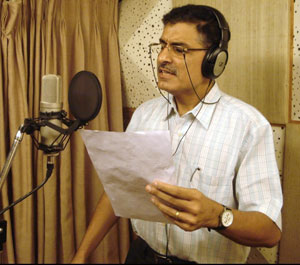|
How to Improve
Voice Quality |
| Neeraj M. Mehra |
| |
| Los Angeles speech pathologist Morton Cooper believes there may be two pitch levels in every voice, an optimal or natural level and a habitual one. To find the proper pitch, Cooper recommends an exercise called the instant voice press. "Standing, place your index finger just under your sternum (where your ribs come together). Now press gently with a staccato movement and make sound with the lips closed." Saying "ummmm-hmmm" can help, adds Cooper, author of "Change Your Voice, Change Your Life" (Harper & Row). Proper breathing - from the midsection of the chest - is also important, Cooper says. "Most women breathe with the upper chest," he finds, partly from habit. 'Hold in your stomach.'" That may be good for the profile, he adds, but it impairs effective speaking. |
|
|
| |
| Nasal. Don't think you are? Deborah Ross, a Santa Rosa speech pathologist, suggests this quick test: Touch the sides of your nose when you speak. "If it vibrates, too much air is passing through the nose, causing a nasal quality to your speech," Nasal speakers often don't open their jaws wide enough, adds Glass. Move the voice forward, suggests Cooper. "Practice saying 'right' or 'really.'' |
| |
| Now what is required to be a voice artiste… first you should be having a good command over the language you speak. You should know how that word is spoken and what does it mean. Second, the fluency in your speech. You should be able to read and speak it fluently without any stammer, lisp or stutter. You should have clarity in your diction, i.e…you should know the correct form of spoken language of the particular region. I believe, many of you are through with two pre-requisites. Now comes how to throw your voice with proper modulation, pitching. Or in simple terms how would you put emotions in to it. This delivery of voice is the most difficult part but also the easiest as you can train yourself rather quickly than overcoming any natural problem. |
| |
| Nonauthoritative. Voices without authority often lack projection and inflection, experts say. To enhance projection, Glass advises bearing down and out with abdominal muscles and adding inflection. Emphasize adjectives, she adds. "Avoid ending strong statements with upward inflection." Ross says, noting "Speaking with vocal question marks is a common mistake made by women." Too fast or too slow. "Fast talkers convey the image of being nervous." says Ross, who thinks a too-slow rate is no better. "Slow talkers look and sound a little dull. They're perceived as having no energy, no initiative." For some, the real problem may be fluency breaks due to incorrect breathing, says Anett Grant of Executive Speaking in Minneapolis, a voice coach who combines movement exercises with voice training. Slowing body movement will slow speech, she reasons, though one speech pathologist dismissed the idea. In one such exercise, Grant tells clients to wave a scarf slowly in front of them as they talk. "Make a smooth, slow movement," she advises, "and let your voice follow that movement." Glass tells fast-talkers to practice taking in a breath and holding it. While exhaling, say. "Hello, how are you?," drawing out each vowel for about two seconds. |
| |
| Ideal. The best voices share several characteristics, Glass believes. "They exude warmth and enthusiasm and have a lot of inflection." Voice improvement doesn't mean taking on someone else's voice, Ross says, noting "I don't change my client's voices. I change the way they use their voices." Nor is voice improvement only a matter of mastering mechanical exercises and correct breathing. Voice problems are often tied in with voice image, Cooper says, which in turn reflects self-image and self-esteem. "A lot of women have trouble changing their voices because they won't accept maturity," Grant maintains. |
| |
Adjusting to New Sound Changing the voice can be done in a single session. But changing the image itself may take much longer. Even those with a healthy voice image may need to adjust to a new sound, Cooper finds. Often, they think they're speaking too loudly or too forcefully, assurances to the contrary.
|
| |
Here are some of their suggestions for correcting problem voices
VOICE - Nasal
PROBLEM - Too much air passes through the nose, making speaker sound whiny and immature.
ADVICE - Open jaw wider. Practice moving the voice forward by saying "right" or "really
VOICE - Non-authoritative
PROBLEM- Speaker seems unsure because of lack of projection, inflection. Rising intonations at end of sentences make strong statements sound like questions.
ADVICE- Project more by bearing down and out with abdominal muscles. Increase inflection. Don't end strong statements with "vocal question marks."
VOICE - Too High or Low
PROBLEM - Unnatural pitch. High voices sound too emotional; low too boring. Both can damage vocal cords.
ADVICE - To find proper pitch, stand, put finger under breastbone. Press gently with staccato movement and say "umm-hmm" with lips closed.
VOICE - Too Fast
PROBLEM - Fast talkers seem nervous, and uncertain, sometimes conveying a sense of indifference.
ADVICE - Practice taking in a breath and holding it. While exhaling, say "Hello, how are you?" Draw out each vowel for about two seconds. |
| |
| Sources: Morton Cooper, Lillian Glass, Anett Grant, Deborah Ross, Los Angeles Times |
| |
| We are always with the aspiring Voice Talent in every aspect mentioned above. Hope to bring smile on your face, always. |
|
| |
| Back to Article on Voicing |
| |
| |
|
